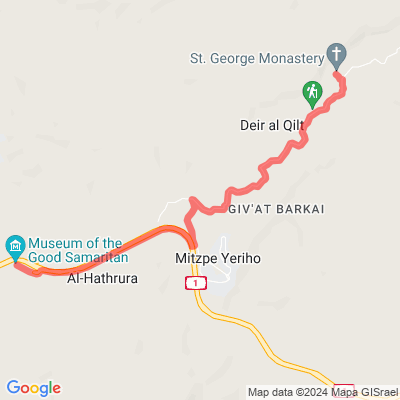
Museum of the Good Samaritan to St. George Monastery
Motorcyclist Map

Route Suggested By: Helio Diamant - https://diamant.org.il/blog
View In Google Maps: https://maps.app.goo.gl/NkMGLzHTMUUhYcRZ6
GPX Download: https://drive.google.com/file/d/1t4-xMXR3aetoYVA_yliQ4fommlQ6O5XE/view?usp=sharing
Description: As a motorcyclist tourist, you’ll find the Monastery of Saint George of Choziba to be a captivating and off-the-beaten-path destination in Judea. Let me guide you through its intriguing history and features: Location and Setting: The monastery is perched dramatically in the rocky landscape, hanging solitary in the deep gorge of Wadi Qelt. It lies in the desert of Judea, along the road connecting Jericho to Jerusalem. The cliffhanging complex emerges from a Lavra, a type of monastic dwelling carved into the rock. Historical Significance: The Monastery of Saint George of Choziba is one of the oldest monasteries in Israel, dating back to the 6th century. It stands contemporaneous to other great monastic centers like Saint Savvas and the Lavra of Saint Theodosius. The monastery is dedicated to the Theotokos of Choziba, built over the ruins of the Choziba Lavra. According to tradition, this place was protected by the Theotokos (the Virgin Mary). Legends and Sacred Origins: The cave within the monastery complex is believed to be where Prophet Elijah found refuge, fed by a raven. Joachim and Anna, parents of the Theotokos, had a connection to this area. Anna prayed for a child, and Joachim fasted in the desert cave until the angel announced the birth of the Theotokos. The monastery’s roots intertwine with biblical narratives and ascetic devotion. Monastery Complex: The structure comprises three floor levels: Main Church: A one-aisled basilica with a dome, dedicated to the Birth of Theotokos (“Theotokos of Choziba”). Prophet Elijah’s Cave: Located on the third level, where the prophet sought refuge. Ascetic Cells, Monks’ Cells, Guesthouses, and other complementary areas. Paintings and Inscriptions: The walls bear paintings of Christian symbols and inscriptions naming homelands and buried fathers. Historical Peaks and Decline: The monastery flourished under Hegoumen Saint George of Choziba in the late 6th century, with over 2000 monks. Saint George Choziba’s tomb rests in the old 6th-century chapel. The current building, constructed in 1878, replaced the ruins of the old Choziba Lavra. The chapel dedicated to the five Syrian monks, the monastery’s first founders, stands as a testament to its enduring legacy. Visiting the Monastery: You will have to walk from the parking place (where you can see the monastery far away) to the entrance. Prepare for a nice hike to reach this breathtaking destination. The rugged terrain and spiritual aura make it a unique experience for motorcyclists seeking more than just scenic views.
Admin Country: Israel